TAPAS.network | 25 October 2024 | Reviews and Reflections | Ian Coles
TRICS and Vision-Led Transport Planning: A New Era of Innovation and Development

For the past 35 years, the TRICS system of trip generation analysis has been part of the Transport Assessment of thousands of new developments through the planning process. Originally mainly concerned with their traffic impacts, the platform has developed and expanded continuously to address emerging new requirements, with examples including its introduction of multi-modal surveys and incorporation of detailed Travel Plan information. In this article, charts the evolution and adaptation of TRICS and outlines the steps taken so far for it to support vision-led Transport Planning, with work on this ongoing.
EVER SINCE TRICS was first launched in 1989, born from the idea of combining traffic surveys on dot matrix printouts, occupying various cupboards at the premises of a number of County Councils, into a unified computerised database, it has been a project of vision. In fact, it has been a project of many visions, through 35 years of its growth, improvement and development.
There have been many milestones throughout this period. TRICS would not have developed in the way it has without the input of foresight, plus the unique and ongoing interaction the project has enjoyed with its users, suppliers, clients and associates, collectively known as the TRICS Community. The continuous formulation of ideas has been a driving force in maintaining TRICS as the system of trip generation analysis for the UK and Ireland, and it has been essential that TRICS has constantly reacted to changes in the Transport Planning industry, whilst at the same time providing countless pre-emptive innovations to keep pushing our system forwards in ever-changing times.
Throughout my own 33 years of working on this project, joining it as a Technical Assistant at JMP at a time when MS-DOS roamed the Earth and a bunch of staff had to share a single computer (although TRICS had its own – thankfully), I have seen and been involved in most of the visionary improvements and enhancements that have led to our system being as it is today. It has not stood still. It has continuously evolved and adapted, and of this there are countless examples. The transition from MS-DOS to the Windows operating system was a big undertaking back in the day. At that time this was a major step change for many systems and organisations, as it meant a whole new approach to software design, process and presentation. The introduction of multi-modal TRICS surveys in the year 2000 was another example of vision leading to practical application, as was the introduction of the Standardised Assessment Methodology for the monitoring of Travel Plans, another major enhancement to the project in 2005. In the same year, the TRICS Good Practice Guide was first published, providing extensive guidance on the best way to use our system at a time when it had grown both in terms of its database, features and functions. It remains a vitally important document to this day. TRICS became an online web application in 2007, which was another major evolutionary step, and a thorough redesign of the system, which we know as TRICS 7, was delivered in 2013. Throughout the history of TRICS, there are countless other examples of individual innovations within various elements of the project that are too many to mention, but the main point being made here is that TRICS is an ever evolving and improving entity that is readily adaptable to changing approaches in our industry. This has required vision and a willingness to both react to change and to be brave enough to take big steps forward where there might be uncertainties. It is an approach that has served us well.
TRICS: Misconceptions and Preconceptions versus Reality
Although we have always looked at ideas for improvements for TRICS, consulted with the many members of the TRICS Community, implemented countless enhancements and provided guidance and assistance on how our system should be used, there have remained some fundamental misconceptions amongst a few regarding the purposes of TRICS, its available functions and abilities and how it is used. This is not something which is widespread by any means, as we put great emphasis on communicating with the TRICS Community and beyond, but it is something that I would like to address.
When you break it down to the core, TRICS is fundamentally a flexible and comprehensive tool for trip generation analysis, with a database of almost 10,000 surveys covering a wide range of development types across the UK and Ireland, and with this number significantly increasing year on year. It is a solid evidence base with an excellent reputation for detail and quality, which is why it is used by well over 300 organisations, both in the public and private sector. However, it is also much more, as I shall explain.
There are a number of things that TRICS is, and a number of things that TRICS is not. For example, a few people may fundamentally misunderstand TRICS and consider it a “tool” for Predict and Provide which generates “worst case scenarios” and “perpetual traffic growth”. This is wholly incorrect and completely misrepresents the purposes, functions and abilities of our system. Such a misplaced assumption may be the result of a lack of experience in using the system, or it may be a preconception that someone wants to believe (or it could be both!) Fortunately for Transport Planners, the reality is far different. The truth is that TRICS provides practitioners with a range of potential trip generation possibilities, and this is evident throughout the functions of the system, for example within rank order lists, trip generation scatterplots and trip rate comparison graphs when looking at selected surveys during the calculation process. In fact, we avoid using the word “predict” at all costs!
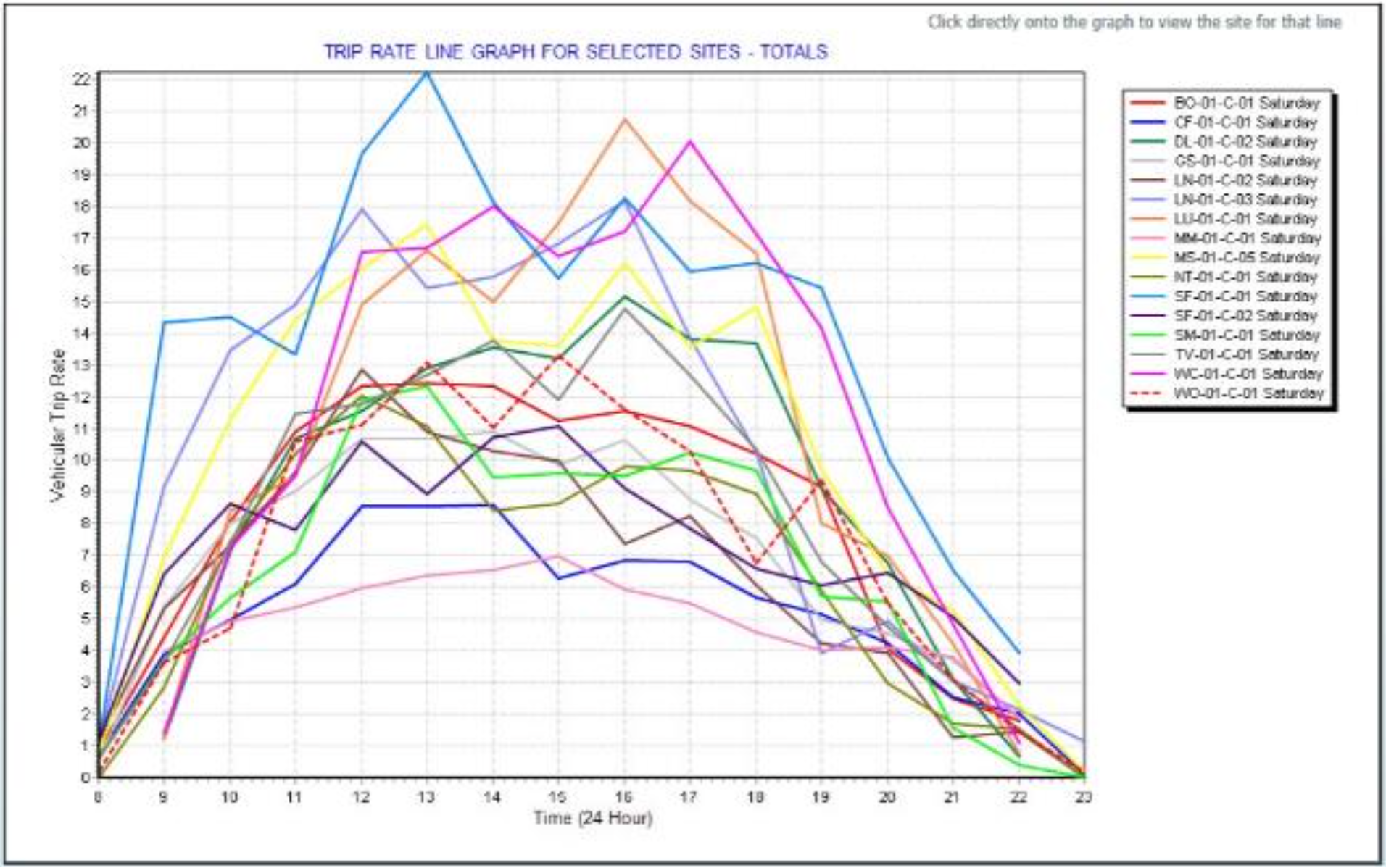
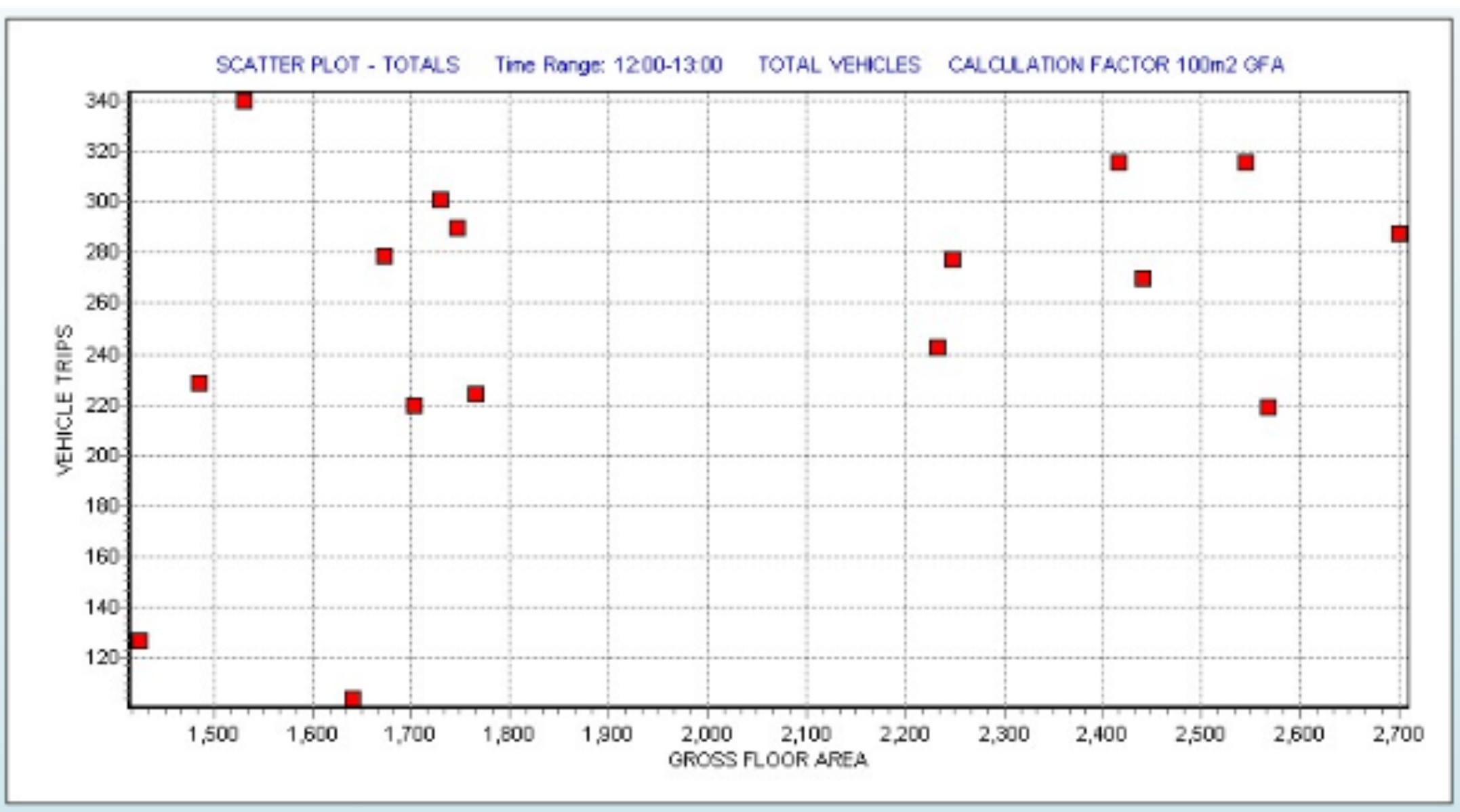
TRICS does not predict a trip rate. Instead, it provides a range of possibilities for the interpretation of practitioners using their professional judgement.
It is important to understand that the question is not whether TRICS as a system is relevant to Vision-Led Transport Planning, because as I will explain it most definitely is. This question is in itself a red herring, and demonstrates a lack of an essential understanding of what TRICS is. TRICS provides the evidence base from which practitioners must exercise their professional judgement and apply the data at their disposal in the most correct way. Therefore, the question should be rephrased and ask how practitioners are using TRICS. For example, is our comprehensive Good Practice Guide being followed? As mentioned earlier, this is a document that I first wrote back in 2005, which is designed to protect those tasked with undertaking Transport Assessments as well as those tasked with auditing them, by encouraging the best and most appropriate use of our system. Just like TRICS itself, it has continuously evolved and adapted (and grown) since it first appeared. This guidance is essential reading for any TRICS user, and it has been used and quoted up to Public Inquiry level. TRICS is a very large evidence base, and provides its users with a comprehensive variety of tools with which to undertake the trip generation analysis that is a necessary, fundamental and integral part of the Transport Assessment process. The key is always to undertake this work in the correct way.
Another misconception might be that TRICS contains “a bunch of old traffic surveys”. Again, this is a misunderstanding that could easily be made should someone not be familiar with the project and how it has evolved and adapted over time. There are over 300 surveys per year undertaken for TRICS, covering a myriad of development types, and this has been made possible by the number of our licenced user organisations. Licence fees are reinvested into the database through these comprehensive data collection programmes, and since the year 2000 we have been undertaking a programme of multi-modal surveys which record all types of trip generation, including of course pedestrian and public transport activity. Through time, the system has also developed so that our surveys include comprehensive descriptive sections of information to accompany the survey counts, adding significant further value. Examples of this information include detailed public transport and accessibility data (including a recently added Traffic Calming sub-section), location details on the local environment and surroundings, and on and off-site parking information.
From 2005 we went one step further, with the introduction of our Standardised Assessment Methodology (SAM) surveys, these being specifically commissioned surveys to monitor Travel Plans, and for which we developed a further comprehensive Travel Plan data section and Travel Plan Monitoring Report generating facility.
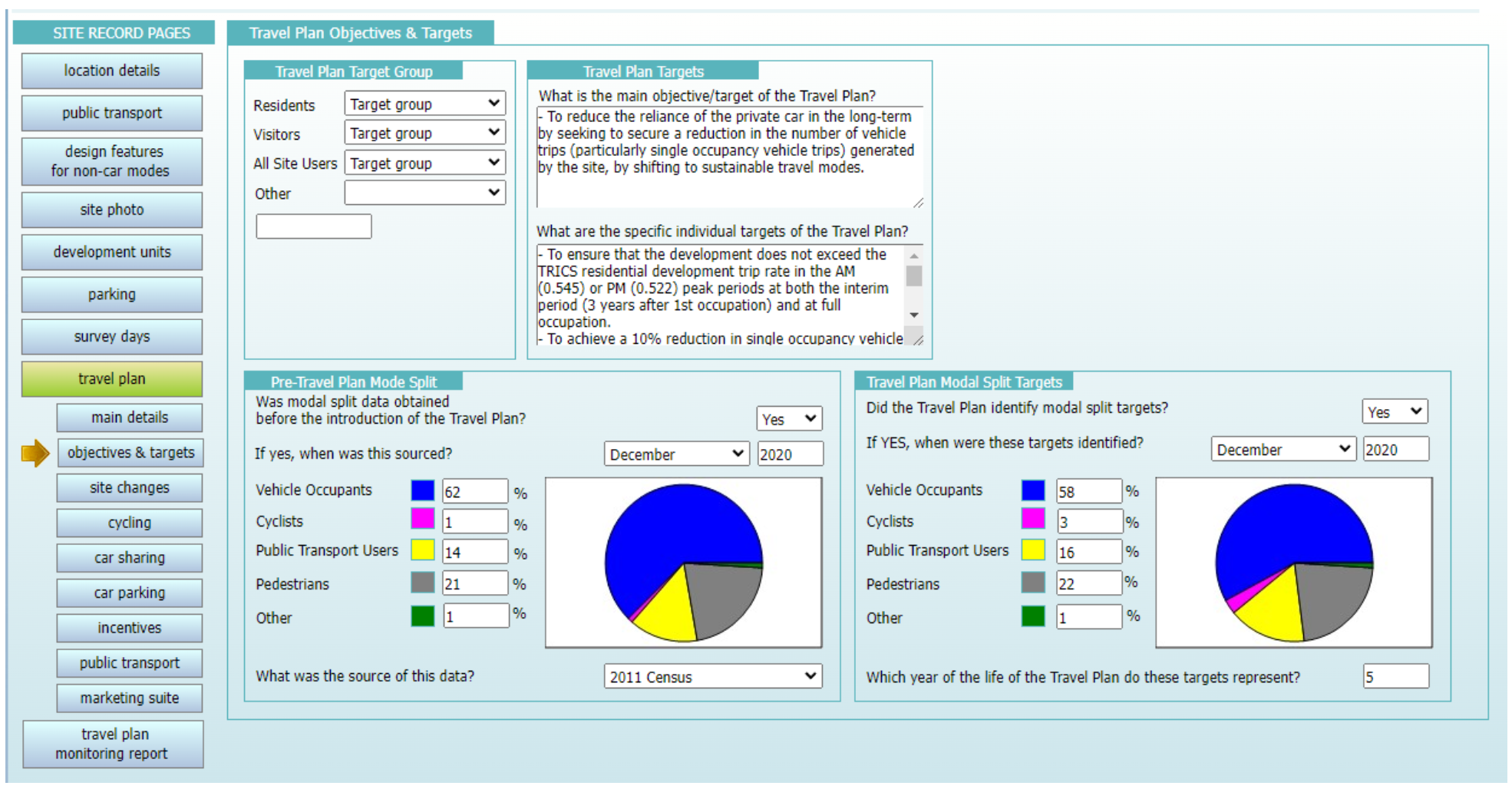
The monitoring of Travel Plans through TRICS-compliant multi-modal surveys is the basis for the TRICS Standardised Assessment Methodology (SAM).
The almost 10,000 surveys currently available within TRICS is a wealth of data, being the result of 35 years of continuous commitment and investment. The value of our system is the quality, quantity, diversity and detail of its data. This has provided the means for developing a dynamic and flexible system of trip generation analysis that means TRICS is ideally positioned to be the evidence base necessary for the practical implementation of Vision-Led Transport Planning.
Having said these things, this is not solely intended to be a backs against the wall defence of TRICS (although clearly I will robustly defend our project when it comes to misconceptions and preconceptions about its functions and intended use). As said earlier (and probably more than once), we endlessly look at ways to develop our system further to meet the needs of its users through times of change. There is no complacency at TRICS Consortium Limited and there never has been. We welcome with open arms all suggestions for further improvement and enhancement from all members of the TRICS Community and beyond, because this is the way we have always worked , and it is the way that has brought results and taken us forward through every evolutionary stage of our project. We don’t intend to stop this approach any time soon!
More Than Just a Database
We have recently placed an increased emphasis on explaining to the TRICS Community that the wealth of survey data that we have accumulated, along with the features and functions we have introduced into the system over time, mean that as well as operating as a system of trip generation analysis, the use of TRICS can provide its users with much more. There are no better examples of enhanced use of TRICS than the series of technical analyses and reports that have been undertaken by TRICS Consortium Limited and made freely available to everyone via our website.
Undertaking technical analyses using our own data is an excellent way for us to conduct research projects at no cost (sounds great doesn’t it?). When you have at your disposal a vast number of surveys, it makes perfect sense to add to their ultimate value by undertaking comparative trip generation studies using TRICS itself, and in recent years we have upped the number of these studies taking place. Some of these are the result of suggestions from members of the TRICS Community, whilst others have come about through discussions amongst the members of the TRICS team. Either way, every project of technical analysis has been useful and well received, and has sometimes thrown out some unexpected and very helpful results which have provided significant food for thought.
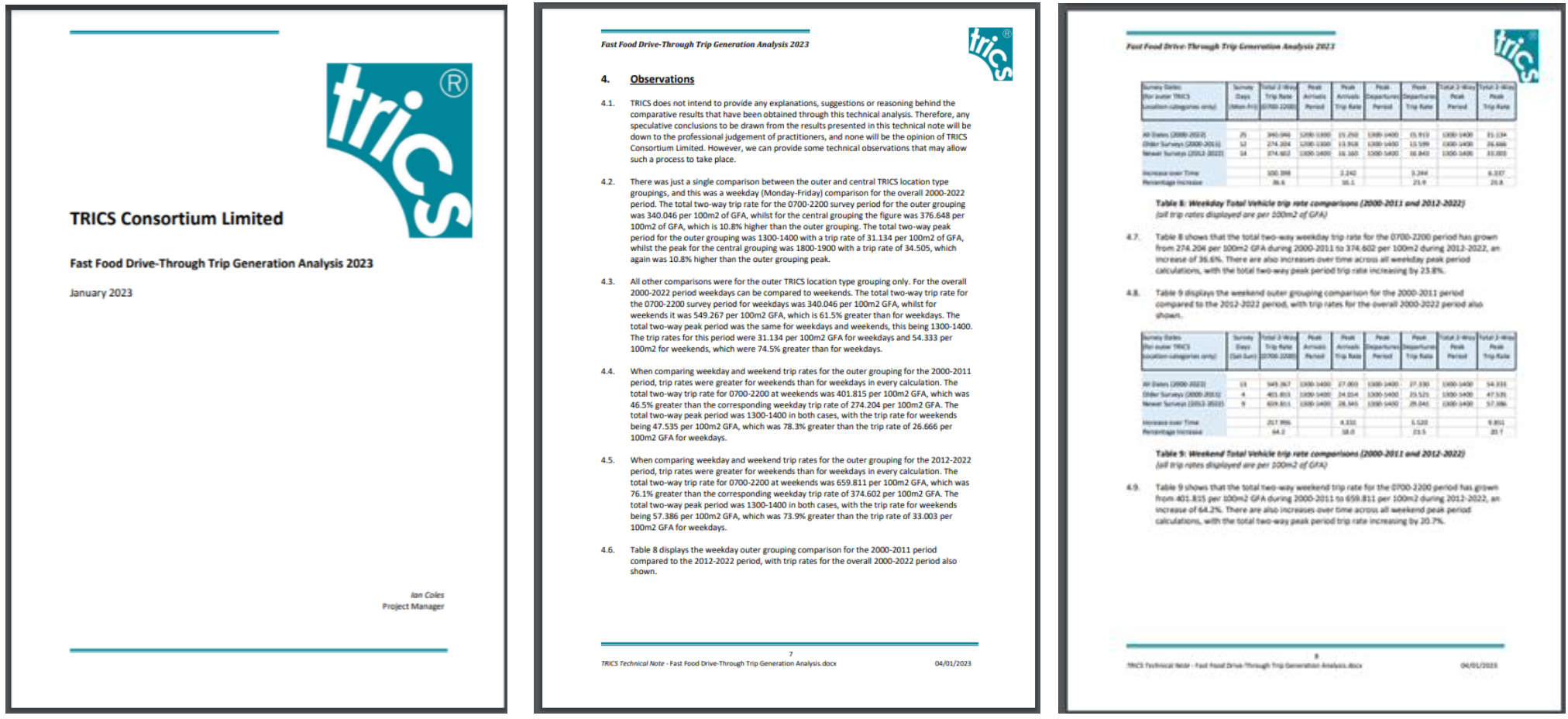
A variety of technical analyses using the wealth of TRICS data at our disposal have been undertaken by the TRICS team, with the results freely available as Technical Reports at our website.
Examples of more recent technical analyses include Fast Food Drive-Through Trip Generation Analysis (2023), Vehicle Occupants Analysis for Selected Development Types (2023), PFS Comparative Analysis (2022), Residential Sub-Category Comparative Analysis (2022), and A Comparison of Vehicular Trip Rate Variation by TRICS Regions and Location Types (2019). There will no doubt be many more of these to come, and in 2024 we have undertaken an analysis of construction activity at 26 TRICS SAM sites, results of which will soon become available.
We will continue to emphasise the flexibility of TRICS and will encourage this enhanced application of our available data by our users for projects being undertaken which may require more than sets of more standard trip generation calculations, because there is so many ways that the system can be utilised that many might be unaware of.
Deciding the Vision and Providing the Evidence
It is all very well for me to say that TRICS is ready and able to be the evidence base for the practical implementation and application of Vision-Led Transport Planning, but what have we done to contribute to this new approach and way of thinking to date? Let me take you back to 2021, and the publication of the TRICS Guidance Note on The Practical Implementation of the Decide & Provide Approach to undertaking Transport Assessments (which is also freely available from our website by the way).
The introduction of Decide & Provide has been the result of several years of research and development, most notably undertaken by Lynn Basford (of Basford Powers and from September 2023 until September 2024 the Interim Managing Director at TRICS), and Glenn Lyons (Mott MacDonald Professor of Future Mobility at the University of the West of England). This work also encompassed the combined experience, knowledge and expertise of contributors from a variety of disciplines, making this a fine example of team effort.
Following the initial academic work which formed the theoretical ideas of Decide & Provide, it was important that an independent technical analysis of historic trends trip generation was undertaken to further inform the development of this new concept with hard evidence. This task fell to TRICS, and was undertaken by Owen Edwards (who is now the TRICS Project Manager). Focusing on a selection of key land uses with robust sets of survey data, a comprehensive analysis of trip generation over time took place, looking at both vehicular and multi-modal activity. The subsequent results were compared with the initial Decide & Provide academic work, and it was found that there were significant correlations between the data sets, with both showing instances of reductions of vehicular trip generation over time, and not, as some might assume, showing continuous traffic growth (so much for TRICS being a Predict and Provide tool then!) Detail of this work is included within the 2021 Decide & Provide Guidance Note.
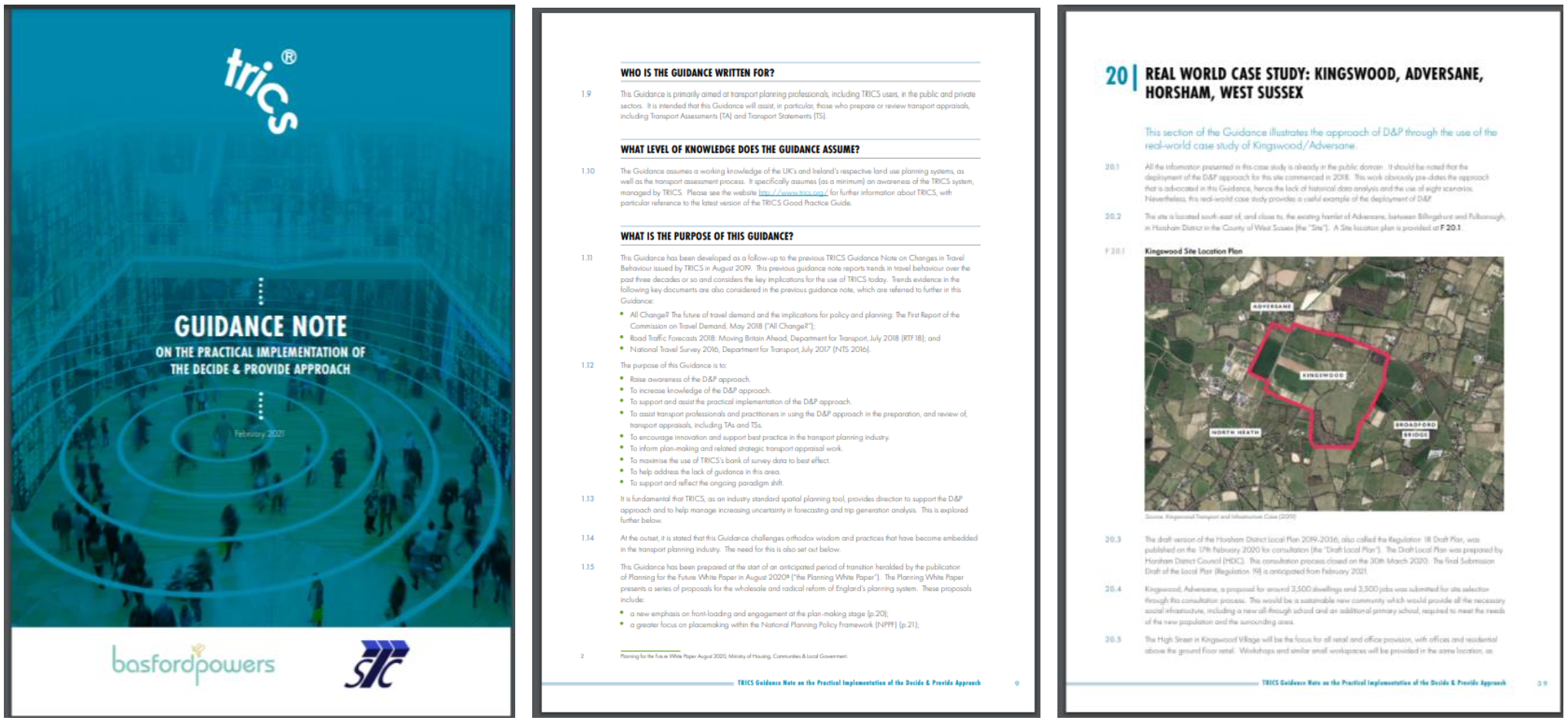
The Decide & Provide Guidance Note is built on a solid foundation of academic and professional research and development, plus hard evidence provided by the wealth of data contained within TRICS.
The evidence obtained through the technical analysis undertaken by TRICS was not only of great value to the development of Decide & Provide; it was also of great value to TRICS itself, as it clearly demonstrated an enhanced value of older survey data and its usefulness for this Vision-Led approach.
An example of the TRICS historic trends work undertaken (and how it was presented in the Guidance Note) is shown below, along with an important diagram which pulls together extrapolated TRICS trip generation trends, national informed projections (heading in the other direction i.e., upwards), and a Vision-Led (supply-led) projection. It is clear that future work will involve the interface of TRICS trip generation results and Vision-Led projections. This will require input from numerous sources, but TRICS welcomes this challenge and is ready and willing to engage with all parties and stakeholders in Vision-Led Transport Planning to take our system to a new level. It will, as always, require a team effort, but the foundations have been built and we are more than ready to continue our role in assisting the development, implementation and practical application of Decide & Provide which, instead of merely being just a theory, is a well-researched method of undertaking Transport Assessments through a new approach which is built on a solid foundation of hard evidence.
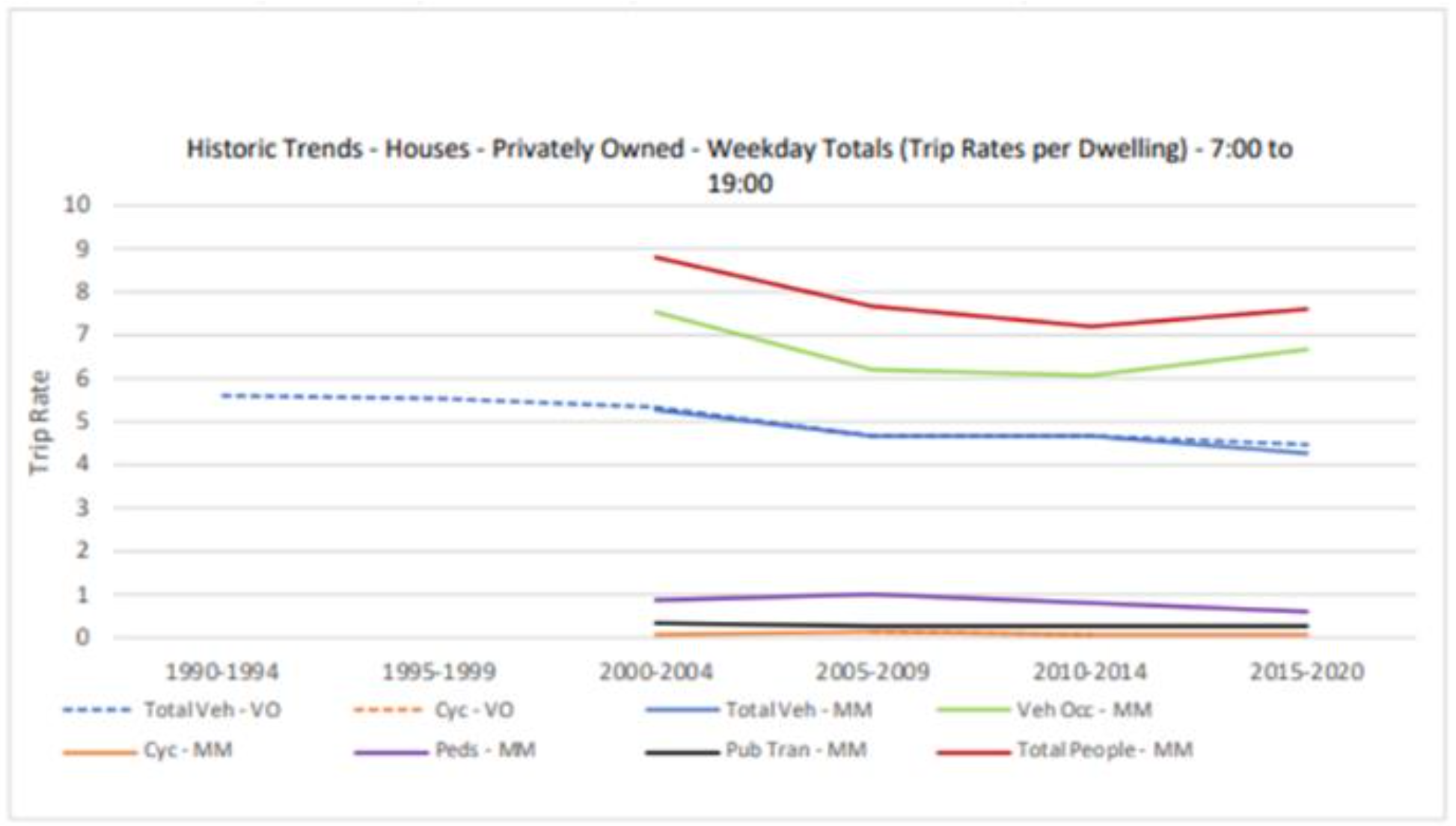
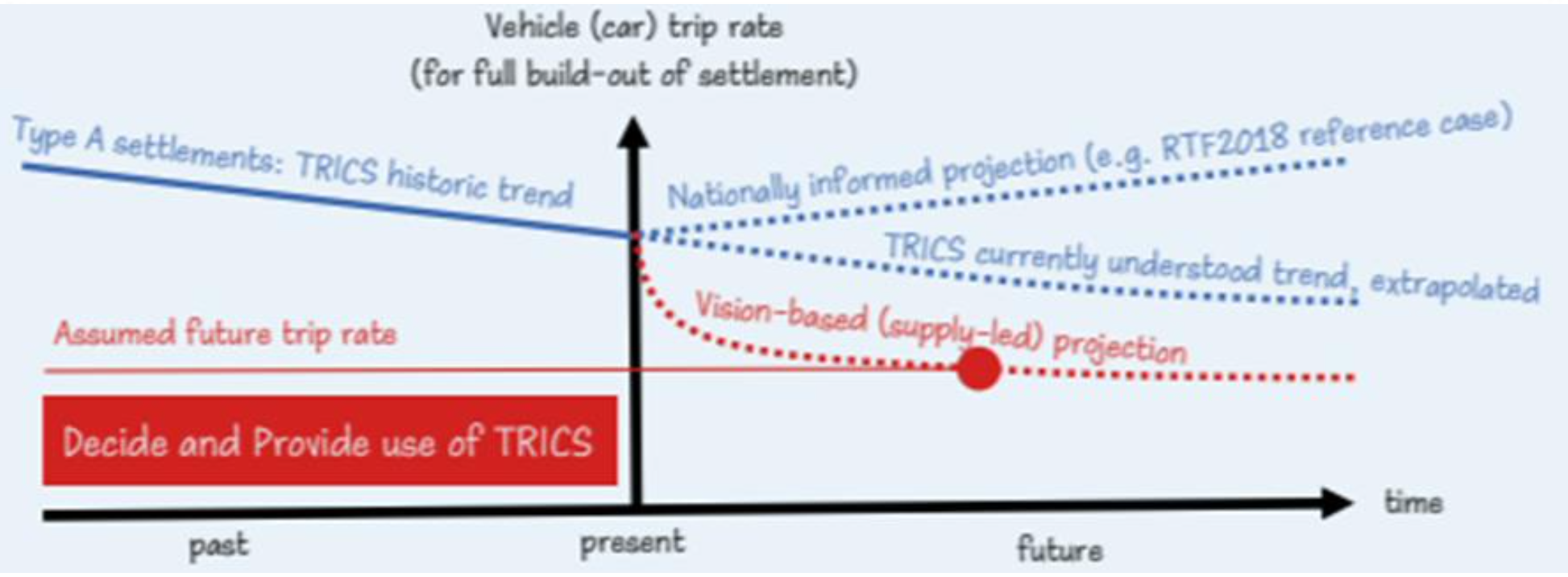
The contribution of TRICS data analysis towards the Decide & Provide Guidance Note was of great importance in establishing a new and evidence-based paradigm for Vision-Led Transport Planning.
Co-operation in Co-ordinating our Visions
This new era of innovation and vision comes at a time when TRICS has embarked on its own journey of redevelopment and improvement, via our TRICS 8 project. We are working with our systems developers to undertake what will be the biggest upgrade and redesign of our system ever undertaken, and the whole TRICS team is looking forward to delivering this to our users, with the first live version of TRICS 8 being scheduled for launch in March 2025. Our new system will provide improved efficiency and user-friendliness and will incorporate a whole new look and feel that will modernise TRICS and open up a whole new world of future development possibilities. As you can probably tell, I am very much looking forward to seeing this being developed myself! TRICS 8 will also include a new and important feature which will see the next stage of integration between TRICS and the practical application of Vision-Led Transport Planning, and this will be revealed at the TRICS User Meeting in London on the 26th of November 2024, so if you haven’t booked your place yet I encourage you to do so (information is provided on our website at www.trics.org).
We want to work with all stakeholders and interested parties in Vision-Led Transport Planning to make it work, and to express how TRICS can be fully utilised for this new approach with the wealth of real-world data at our disposal, providing practitioners with the tools they need to achieve the new approach’s full potential. We welcome recent commentary from the Transport Planning Society and the Fixing Transport Assessments Group which promotes the application of Travel Plans, of which TRICS has built a sizeable evidence base through our SAM surveys. Over the past four years we have seen a significant increase in the number of SAM commissions, which has been most welcome, including a growing demand for surveys at large, mixed use developments. With our Travel Plan Monitoring Report facility also recently updated and improved, we would like to co- operate with everyone to see how we can also take the SAM process and content to the next level, so we welcome input from all.
The draft update to the National Planning Policy Framework (NPPF) has resulted in many responses from a variety of sources. There will no doubt be further discussion and debate, which of course is always healthy, and TRICS is fully prepared to play its role in the future of Transport Planning, as it has always done through 35 years of development, innovation and adaptation.
We embrace the concept of Vision-Led Transport Planning, but what is the vision without a real- world and extensive evidence base from which to turn the vision into practical reality? TRICS stands ready to be this evidence base to help take Transport Planning forward, with a reinvigorated system that has always adapted and evolved, and which will meet new challenges head on with an attitude of co-operation, enthusiasm, vision and energy.
Ian Coles is the Managing Director of TRICS Consortium Limited. He has worked on TRICS for 33 years, with 20 of these in the role of Project Manager.
You are currently viewing this page as TAPAS Taster user.
To read and make comments on this article you need to register for free as TAPAS Select user and log in.

Log in